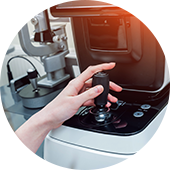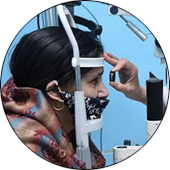- Email: Sushil_60@yahoo.com
- 4/15, sector -5, rajendra nagar
- Call: +91 98100 32030
Dry Eye Test

20
Years of Experience in This Field
The Great Place Of New Vision Eye and Medical Care. Best Eye Care Clinic in Ghaziabad.
"The Great Place Of New Vision Eye and Medical Care" is the premier Eye Care Clinic in Ghaziabad, dedicated to providing top-notch medical and eye care services to the community. Our mission is to offer comprehensive, compassionate, and state-of-the-art eye care to improve the vision and overall well-being of our patients.
Our Mission
- High-quality work
- Innovation and Research
- Rapid response times
Our Vision
- Best Price
- Best Treatment
- Emergency solutions
What is a Normal Dry Eye Test?
A normal dry eye test, also known as an ocular surface evaluation or dry eye assessment, is a diagnostic procedure performed by eye care professionals to determine the presence and severity of dry eye syndrome (DES) or dry eye disease. Dry eye is a common condition characterized by insufficient or poor-quality tears to lubricate the eye's surface, leading to discomfort, irritation, and potential damage to the cornea.
The dry eye test typically includes several components, and the specific tests or methods used may vary among eye care providers. However, here is a general description of a typical dry eye evaluation:
Patient History: The evaluation usually begins with the eye care professional asking the patient about their symptoms, such as eye discomfort, itching, burning, redness, sensitivity to light, and the use of medications that could contribute to dry eye.
Visual Acuity: Standard eye charts are used to assess the patient's visual acuity to
ensure
that any vision problems are not contributing to the discomfort.
a. Tear Breakup Time (TBUT): This test measures how long it takes for the tear
film to
break up on the surface of the eye after a blink. A shorter TBUT may indicate unstable tear
film.

b. Schirmer's Test: A strip of filter paper is placed under the lower eyelid to measure the amount of tears produced over a certain period. Low tear production can be a sign of dry eye.
Fluorescein and Lissamine Green Staining: Special dyes, such as fluorescein and lissamine green, may be used to evaluate the integrity of the corneal surface and the conjunctiva. Staining patterns can reveal areas of damage or dryness.
Meibomian Gland Assessment: The meibomian glands in the eyelids play a crucial role in producing the oily layer of tears. An evaluation of these glands may involve expressing meibomian gland secretions to check for blockages or abnormalities.
Osmolarity Testing: Osmolarity measures the concentration of solutes in the tear film. Elevated tear osmolarity can be a sign of dry eye.
Inflammatory Marker Assessment: In some cases, tests may be performed to measure the levels of inflammatory markers in the tears, which can help identify the presence of inflammation associated with dry eye.
Additional Tests: Depending on the findings and the patient's specific symptoms, other tests or imaging techniques like tear meniscus height, corneal topography, or infrared imaging may be employed.
A normal dry eye test result would indicate that the patient's tear film is stable, their tear production is sufficient, and there are no significant abnormalities or signs of inflammation or damage on the ocular surface. However, if the test reveals abnormalities or symptoms consistent with dry eye, the eye care professional can develop a treatment plan to alleviate the discomfort and improve the patient's eye health. Treatment options may include artificial tears, prescription medications, lifestyle modifications, or procedures to unblock meibomian glands, among others. It's important to note that the specific diagnostic criteria and tests may vary between eye care providers, and a comprehensive evaluation is essential for an accurate diagnosis and appropriate management of dry eye.
A Global Leader, Treatment
of eye Disease

Heart Disease
Heart disease, also known as cardiovascular disease, refers to a group of conditions that affect the heart and blood vessels. It can encompass various disorders such as coronary artery disease, heart failure, arrhythmias, and valvular diseases.

Pediatric Ophthalmology
Pediatric ophthalmology is a medical specialty focused on the diagnosis and treatment of eye and vision problems in children, from infancy to adolescence.

Lenses Transitions
Transition lenses are a type of eyeglass lens that automatically adjusts their tint in response to changing light conditions. They darken when exposed to UV light and become clear indoors.
How it Helps You to
Keep Healthy

Get Appointment
+91 98100 32030

Start Check-Up
Begin Your Journey to Better Health Today: Start Your Check-Up!

Enjoy Healthy Life
Embrace Wellness: Enjoy a Healthier Life!
Can dry eyes be cured?
Dry eyes, also known as dry eye syndrome or dry eye disease, are a chronic condition that cannot typically be completely cured. However, the condition can often be effectively managed and the symptoms alleviated with a variety of treatments and lifestyle changes. Here's a more detailed description:
Artificial Tears: Lubricating eye drops, also known as artificial tears, are often the first line of treatment. They help to provide temporary relief by supplementing the natural tear film.
Prescription Medications: In some cases, prescription eye drops may be recommended. These can include anti-inflammatory medications, such as cyclosporine (Restasis) or lifitegrast (Xiidra), which can reduce inflammation in the eye and help the eyes produce more natural tears.
Punctal Plugs: These tiny plugs are inserted into the tear ducts to block the drainage of tears, keeping the eyes moist for a longer duration.
Meibomian Gland Expression: If meibomian gland dysfunction is contributing to dry eyes, a doctor may perform a procedure to express and unblock these glands, allowing the natural oils to flow more freely.
Warm Compresses: Applying warm compresses to the eyelids can help soften and release
blocked
oils in the meibomian glands.

Diet and Nutrition: Some dietary changes, like increasing omega-3 fatty acids and
staying
hydrated, may help support overall eye health.
Blinking Exercises: Regularly blinking fully and consciously can help spread
natural
tears across the eye's surface more evenly.
Humidifiers: Using a humidifier in your home or workspace can add moisture to the
air
and help prevent excessive evaporation of tears.
Environmental Modifications: Reducing exposure to dry or windy conditions,
avoiding
smoke, and protecting your eyes with wraparound sunglasses can help reduce
symptoms.
Lid Hygiene: Keeping the eyelids clean and free of debris can improve tear
quality and
reduce irritation.
While dry eye syndrome may not be entirely cured, effective management can significantly reduce symptoms and improve the overall quality of life. Treatment plans may be tailored to the individual, as the causes and severity of dry eye can vary. It's important to work closely with an eye care professional to determine the most appropriate treatments and lifestyle adjustments for your specific situation. In some cases, patients may need ongoing treatment to maintain comfort, while others may experience periods of remission. Regular eye exams and follow-up appointments are important for monitoring the condition and making adjustments to the treatment plan as needed.

